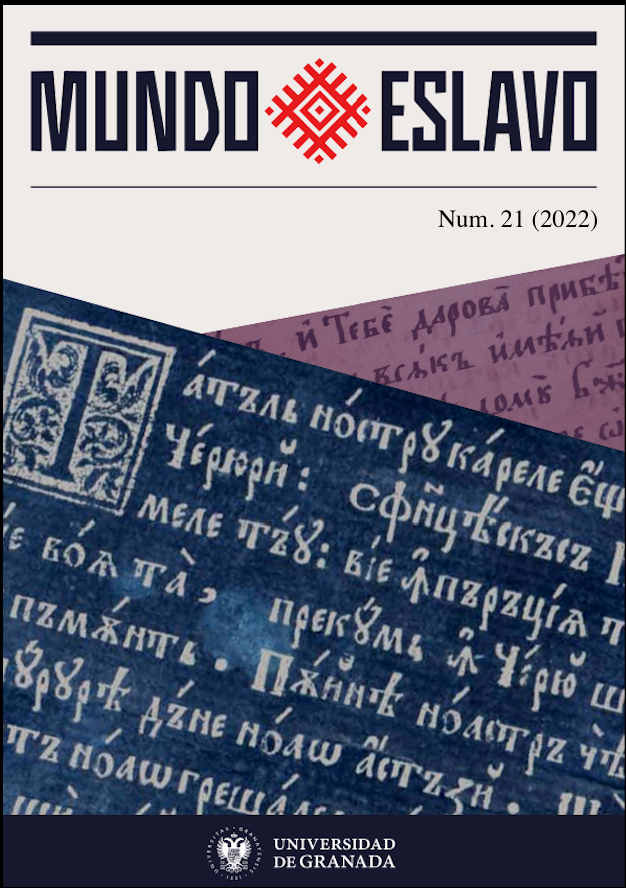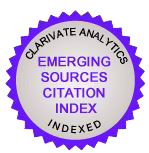Spirit, Matter and Sacrifice: The Aesthetic Dimension of the Spiritual Tradition in Andrei Tarkovsky's Films
DOI:
https://doi.org/10.30827/meslav.vi21.25094Abstract
Andrei Tarkovsky is one of the most important directors in the history of cinema, specially known for his ability to renew cinematographic language, his distinct artistic personality and his important work as a film theorist. Through the seven masterpieces that make his career, the filmmaker offers us an itinerary of great spiritual and philosophical depth, in which Eastern and Western traditions regarding spirituality come together harmoniously. Concepts such as time, spirit, matter and sacrifice are fundamentally important in his work, bringing it close to the psychological novels of Fyodor Dostoyevsky. Tarkovsky's journey as an artist with great character and his categorical rejection of commercial cinema will lead him to a confrontation with the authorities of his country, and he is forced into self-exile. During his exile firstly in Italy and later in Sweden he directs his last two masterpieces, final testimonies of a tormented conscience which has to face the disappearance of the world´s spirituality.
Downloads
References
Bergman, I. (2015). Linterna mágica. Memorias, Barcelona, España: Tusquets editores.
Djermanovic, T. (2017). Estética de Dostoyevski y Tarkovski: la creatividad como visión del hombre, del apocalipsis y de la posibilidad de salvación Estética de Dostoievski y Tarkovsky. Mundo eslavo: revista de cultura y estudios eslavos, 150º aniversario de la publicación de la obra “Crimen y castigo” de Dostoievski (16), 64-72.
Fernández Sánchez, J. (1982). Dostoievski: El realismo psicológico. En Prado, J. y Rodrigo, R. (Ed.), Historia Universal de la Literatura (pp.57-72). Barcelona, España: Ediciones Orbis.
Garcells, A. (2016). Andrei Tarkovski: artista y hombre espiritual. Índex, revista de arte contemporáneo.Arte e investigación (1),18-31.
Goyes Narváez, J. (2016). La mirada espejeante. Análisis textual del film El Espejo de Andrei Tarkovski (Tesis doctoral). Universidad Nacional de Colombia, Colombia.
Lasica, T. (1972). Tarkovsky’s Choice. Alberta, Canada: Nostalghia. Retrieved from http://www.nostalghia.com/TheTopics/Tarkovsky-TopTen.html
Le Cain, M. (2002). Andrei Tarkovsky. Melbourne, Australia: Senses of Cinema. Retrieved from http://www.sensesofcinema.com/2002/great-directors/tarkovsky/
Loughlin, G. (2008). Tarkovsky ́s Trees. En Dune, N. (Ed.), Tarkovsky (pp.80-95). Londres, Reino Unido: Black Dog Publishing Limited.
Markus, S. (2006). Por qué en el este fue distinto: rasgos comunes, hechos diferenciales. En Monterde, J. y Losilla, C. (Ed.), Vientos del Este, los nuevos cines en los países socialistas europeos (pp.13-40). Valencia, España: Institut Valencià de Cinematografía.
Sandler, S. (2008). The absent father, the stillness of film: Tarkovsky, Sokurov and Loss. En Dune, N. (Ed.), Tarkovsky (pp.126-147). Londres, Reino Unido: Black Dog Publishing Limited.
Strukov, V. (2008). Virtualisation of self and space in Tarkovsky ́s Solaris. En Dune, N. (Ed.), Tarkovsky (pp.58-79). Londres, Reino Unido: Black Dog Publishing Limited.
Tarkovski, A. (2017a). Atrapad la vida. Lecciones de cine para escultores del tiempo. Madrid, España: Errata naturae.
Tarkovski, A. (2017b). Esculpir en el tiempo. Madrid, España: Ediciones Rialp.
Tejeda, C. (2020). Andrei Tarkovski. Madrid, España: Ediciones Cátedra.
Yankovsky, O. (1983). How we shot the “Inextinguishable Candle” episode for Nostalghia. Alberta, Canada: Nostalghia. Retrieved from http://www.nostalghia.com/TheTopics/Yankovsky.html
Downloads
Published
How to Cite
Issue
Section
License
Copyright (c) 2022 Mundo Eslavo

This work is licensed under a Creative Commons Attribution-NonCommercial-ShareAlike 4.0 International License.

CC BY-SA: This license allows reusers to distribute, remix, adapt, and build upon the material in any medium or format, so long as attribution is given to the creator. The license allows for commercial use. If you remix, adapt, or build upon the material, you must license the modified material under identical terms.
CC BY-SA includes the following elements:
BY ![]() – Credit must be given to the creator
– Credit must be given to the creator
SA ![]() – Adaptations must be shared under the same terms
– Adaptations must be shared under the same terms
Authors who publish with this journal agree to the following terms:
1. Authors retain copyright and grant the journal right of first publication with the work simultaneously licensed under a Creative Commons Attribution License that allows others to share the work with an acknowledgement of the work's authorship and initial publication in this journal.
2. Authors are able to enter into separate, additional contractual arrangements for the non-exclusive distribution of the journal's published version of the work (e.g., post it to an institutional repository or publish it in a book), with an acknowledgement of its initial publication in this journal.
3. Authors are permitted and encouraged to post their work online (e.g., in institutional repositories or on their website) prior to and during the submission process, as it can lead to productive exchanges, as well as earlier and greater citation of published work (See The Effect of Open Access).













